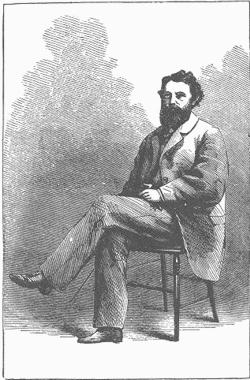Sylvester Mowry: Difference between revisions
(No difference)
|
Revision as of 23:15, 22 October 2010
Sylvester Mowry | |
|---|---|
 An 1864 drawing of Sylvester Mowry by J. Ross Browne. | |
| Allegiance | |
| Service/ | |
| Years of service | 1852 - 1858 |
| Rank | First Lieutenant |
| Unit | 3rd Artillery Regiment |
| Battles/wars | Apache Wars |
| Other work | miner, pioneer, author, politician |
Sylvester Mowry (1830 - October 15, 1871) was an American best known as a pioneer explorer of Arizona. He also served as an officer in the United States Army and was arrested as a traitor during the American Civil War.
Biograpghy
Born in 1830 at Providence, Rhode Island, Mowry attended West Point in 1848 until graduating in 1852 as a lieutenant. Well eduacated, he spoke Latin and later became the author of the 1863 book The geography and resources of Arizona and Sonora. After West Point, Mowry went west and explored with the army for the Pacific Railroad until 1854. In 1856, Mowry was eleced to be a delegate in the 35th Congress for the creation of Arizona Territory but because the bill did not pass, Mowry never took his seat. From then until 1857, Sylvester was stationed at Benecia, California and Fort Yuma. During his military career Mowry became enemies with another officer named James H. Carleton who later arrested him during the Civil War. Mowry served at Old Fort Buchanan before resigning his commission on July 31, 1858. In 1860 he was appointed by President James Buchanan a commissioner to establish the border between California and Nevada, but he was removed in 1861 due to politics. During his time as commissioner, Mowry became interested in mining and prospecting and in 1860 he purchased the Patagonia silver mine in the Santa Rita Mountains of southern Arizona. After renaming it the Mowry Silver Mine, Mowry began constructing a mill and a smelter for extracting precious minerals.
A small settlement formed around the mining works which today is the ghost town of Mowry, Arizona. Mining occupied Mowry's time until 1862, by this time the Civil War had already begun and Confederate Arizona Territory had been established. Though a northerner and Republican, Mowry was a firm supporter of the new territory, as were many other Republicans in Arizona, during the Civil War, the majority of the Confederacy's political leadership were Democrats. The California Column began their advance across Confederate Arizona in 1862 from Fort Yuma, now a general, Mowry's enemy James H. Carleton was in command. After the Union capture of Tucson on May 20, 1862, the Califonians proceeded onto New Mexico, stopping to arrest Sylvester Mowry at his mine. Charged with selling lead to Arizona's Confederate militias, Mowry was detained at Fort Yuma from July 2, 1862 to November 8. He was released after a court appearance in which no evidence could be found that he had ever sold lead to rebels. Despite this fact, Mowry defended himself in court and justified his selling of lead to rebels even though he was found innocent. In his defense he mentioned the basic American principals of Life, liberty and the pursuit of happiness.
Mowry also went on to describe New Mexico Territory, the eastern half being a great place of American progress on the frontier and the other a war zone, ravaged by the Apache and unfit for civilization. Mowry felt an obligation to sell lead to his fellow frontiersmen, regardless of political stance. In the early 1860's the Apache were fighting all across southern Arizona. The Mowry Mine and it's immediate surroundings was the scene of several Apache attacks before the town was mostly destroyed in 1863. Mowry later angrily descibed a way in which to defeat the Apaches;
- "There is only one way to wage war against the Apaches. A steady, persistent campaign must be made, following them to their haunts—hunting them to the fastnesses of the mountains. They must be surrounded, starved into coming in, surprised or inveigled—by white flags, or any other method, human or divine—and then put to death. If these ideas shock any weak-minded individual who thinks himself a philanthropist, I can only say that I pity without respecting his mistaken sympathy. A man might as well have sympathy for a rattleshake or a tiger."
Upon his release from Fort Yuma, Sylvester was denied his land for several years and by the time of his return, the mine was too deteriorated so any attempt to restart operations would be very expensive. Thus Mowry ended his life on the frontier and eventually went to London, England to raise funds in order to return to Arizona. However, he died in London on October 15, 1871. News of Mowry's death reached Prescott, Arizona within days, which was a signifiant communications feat at the time, it usually took months to transfer information from Great Britain to the American frontier. Mowry's legacy is foremost the mine he left behind, it was later resettled and continued to be populated until well after the turn of the 20th century. Mowry is also an important figure in American folklore and is well known in many other American states. As of 2010, several adobe walls from the Mowry Mine are intact. Author J. Ross Browne visited the ruins in 1864 and later wrote the book Adventures in Apache Country describing in detail the mine's infrastructure and history before it was destroyed.
See Also
References
- Browne, J. Ross, (1864 - 1973 reprint), "Adventures in the Apache Country: A Tour through Arizona and Sonora", Ayer Company Publishing, San Francisco, California, ISBN 0405049617
- Mowry, Sylvester (1863 - 2010 reprint), "The geography and resources of Arizona and Sonora: An address before the American Geograpghical and Statistical Society", Nabu Press, New York, ISBN 1148480951
- Sherman, James E; Barbara H. Sherman (1969), "Ghost Towns of Arizona", University of Oklahoma Press, pg.# 103, ISBN 0806108436
